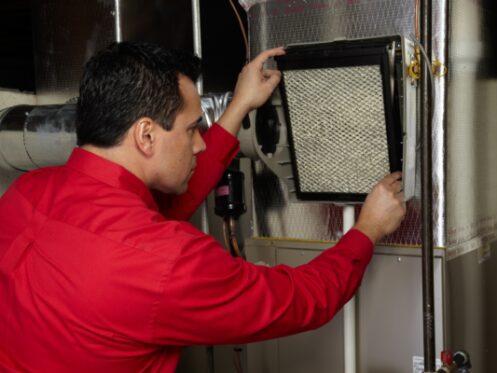Tips for Healthy Indoor Air Quality in the Winter
It’s an unfortunate truth that indoor air quality deteriorates during the winter. This is because homes get sealed up tight, and people choose to stay inside where it’s warm. More people and less ventilation lead to trapped bacteria and pollutants, which reduce the air quality. The U.S. Environmental Protection Agency lists indoor pollution as one of the top five environmental health risks.
Luckily, there are steps you can take to keep your air quality fresh and your family and friends healthy. Let’s go over how you can improve the quality of the air in your home this winter.
Know the Culprits
The first step to keeping your air clean is knowing who the enemy is. Some common culprits that contribute to poor air quality include:
- Mold
- Pet dander
- Microplastics
- Dust mites
- Pollen
- Viruses and bacteria
- Pesticides
- Chemical cleaners
- Tobacco products
- Volatile organic compounds
These are some of the most commonly found pollutants in residential homes, but they aren’t the only potential problems. A qualified technician can help to identify your home’s unique issues.
Have Your Ductwork Inspected and Cleaned
The heating, air, and ventilation ducts in your home can collect dust and other debris. If they have any leaks, these pollutants can end up in the air you breathe.
Having the ducts cleaned will remove potential pollutants and can lead to the identification of leaks or worn areas. You should have your ducts cleaned professionally every three to five years.
Monitor Your Home’s Humidity Levels
When the air is too humid, mold and mildew can form. These are incredibly harmful to humans. Monitoring and regulating the humidity levels in your home can help prevent them from developing and spreading.
Ideally, your home’s humidity should be between 30% and 50%, regardless of the season. In the winter, it’s important to ensure that your home doesn’t exceed 50% humidity. If it does, you’re at risk of developing mold and mildew. To maintain proper humidity, invest in a high-quality humidifier and replace it every 10 to 15 years.
Open the Windows
A simple remedy to help maintain indoor air quality is to let in some fresh air from outside. While this doesn’t sound ideal for winter, don’t worry, you won’t have to freeze yourself out. Even just a few minutes a day of opening the windows can do wonders for your air quality. This can also help relieve any “stuffiness” you may feel inside your house.
Invest in an Air Purifier
Adding an air purifier to your home can help reduce particulates in the air. There are all kinds of air purifiers available, including some with smart technology that lets you control them from your phone.
Make sure you follow all the cleaning instructions, especially with regard to the filter. You need it operating at its best to get the full benefit.
Bring Home a Leafy Friend
Plants clean and purify the air. It’s basically their entire job. Having a few in your home will help lower the number of toxins in the air, improving the overall quality. Make sure to research the plant you choose, as some can be poisonous to pets and people when consumed.
Set a Cleaning Schedule
Carpets, couches, curtains, and other fabric-covered home items are notorious for harboring toxins. Dust, dirt, and pet dander are especially good at hiding in them.
Regular cleaning can help eliminate these contaminants, especially if you have a good vacuum. Don’t forget to get into those corners and other forgotten areas.
Change Your Air Filters
Your home’s air filters should be replaced at least every three months. Not doing so allows bacteria, dust, and other debris to build up and escape into your home. Set a reminder on your phone or mark your calendar to make sure you stay on top of your filter changes.
Eliminate Harsh Chemicals
Strong cleaning products can contain chemicals that stay around long after you’re done cleaning. These chemicals lower the quality of your air and can make you sick. Consider switching to more natural cleaning products. Be sure that the rooms you’re cleaning are properly ventilated. If possible, open a window to help bring in fresh air while you’re using cleaning products.
Groom Your Pets
When the weather turns cooler, many animals develop a thick winter coat. It’s nature’s way of protecting them against the elements. However, what’s good for them may be bad for you. They may shed more indoors. While you should always brush your cats and dogs, you may notice an increased need for that as piles of hair cling to the carpet or float in the air.
Signs of Poor Indoor Air Quality
There are some common indicators that the air quality isn’t right in a home. Here’s what you should be on the lookout for.
Consistent Cold Symptoms
If you or someone in your home have cold symptoms that won’t go away, it could be the air quality. If you’ve experienced coughing, dizziness, nausea, sneezing, or runny eyes over a long period of time, it may be your air.
One way to tell the difference between having a cold and bad air quality is to pay attention to how you feel when you’re not home. If your symptoms improve when you’re away from home, it’s probably the air.
Irritated Skin
If you have a rash, redness, or dry patches that you can’t explain, it could be from air irritants. You should have a doctor rule out other causes, but if they can’t find any, it’s time to address the air quality.
Sleeplessness
People often experience problems sleeping when they’re in polluted areas. If you’ve been getting a poor night’s sleep and can’t identify the cause, this is something to consider.
Strange or Lingering Smells
If there’s a mysterious bad odor around your home, it could be the air. When pollen, dander, and dust build up, they can create an unpleasant smell. If you constantly smell cooking odors, this is often an indication of poor air circulation, which means other pollutants are also likely to be remaining in the air.
Hot and Cold Spots
Having spots in your house that always feel a little cooler or warmer than the rest is also a sign of poor circulation. This indicates that anything, including bacteria, could be hanging around.
Sometimes, this occurs when your HVAC system isn’t adequate for the size of your home. A professional can perform an inspection and let you know if this is the case.
Too Much Dust
If you always seem to have dust on the furniture, it could be your air quality. You may need to upgrade your air filter, get a purifier, or take other steps to combat the problem.
How a Professional Can Help
Our team at We Care Plumbing, Heating & Air specializes in helping you identify and eliminate pollutants in your home. If you live in the vicinity of Temecula, Murrieta, or Orange, we’re here to serve you.
We offer heating, cooling, and plumbing installation, repair, and maintenance services, as well as air quality and humidity control solutions. Give We Care Plumbing, Heating & Air a call today to schedule an appointment!
Related Articles
Healthy Indoor Air
Why Is Air Quality Testing So Important?
Does Opening Windows Increase Indoor Air Pollution?
How Air Scrubbers Can Help You Breathe Easier
The Ultimate Guide to Air Purification vs. Air Filtration
Dry Air and Cracked Skin: Indoor Humidity and Your Home Comfort
How Can Air Balancing Help with Hot and Cold Spots?
Author Bio: Rusty Cochran
 Rusty Cochran is the President of We Care Plumbing, Heating and Air Conditioning. We Care began humbly, operating in his family’s living room. Under Rusty’s strong leadership, We Care has grown from 2 employees to over 200 employees. We Care Plumbing, Heating and Air has gained recognition across the HVAC industry, receiving numerous awards and certifications, including being named the ACCA Contractor of the Year, The Map Presidential Award several times, Angie’s List Super Service Award, NATE certification, and multiple Dave Lennox Awards. LinkedIn Profile
Rusty Cochran is the President of We Care Plumbing, Heating and Air Conditioning. We Care began humbly, operating in his family’s living room. Under Rusty’s strong leadership, We Care has grown from 2 employees to over 200 employees. We Care Plumbing, Heating and Air has gained recognition across the HVAC industry, receiving numerous awards and certifications, including being named the ACCA Contractor of the Year, The Map Presidential Award several times, Angie’s List Super Service Award, NATE certification, and multiple Dave Lennox Awards. LinkedIn Profile







